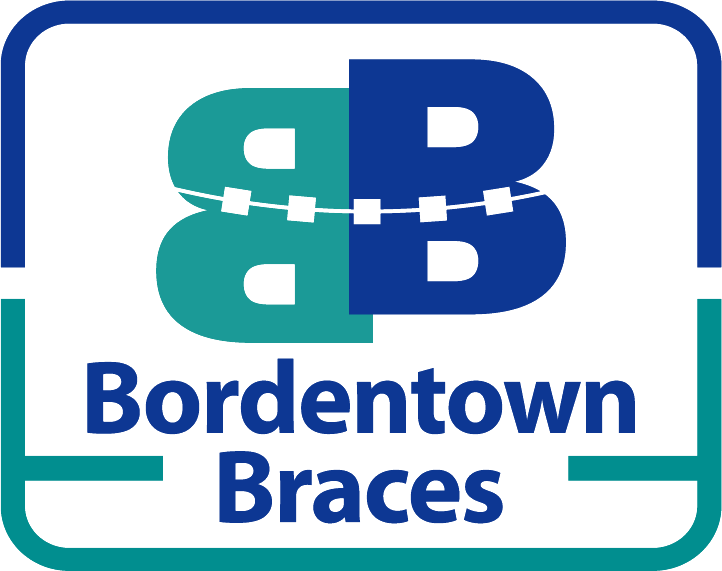Braces First Aid

Emergencies
True orthodontic emergencies are very rare. When you begin orthodontic treatment we will teach you how to handle most orthodontic problems that can arise. You will be very knowledgeable and equipped to solve many problems yourself temporarily until you are able to be seen in our office. With the use of camera phones these days, there is almost nothing that we can’t talk you through over the phone. When talking to us to describe your problem, it will be helpful for you to know the names of the parts of your braces. This way you will be able to identify what is broken or out of place. Below you will find pictures of the part of braces along with their descriptions. If you are able to alleviate your problem and discomfort on your own, it is very important that you still call our office as soon as possible to schedule a time to repair the problem. Allowing your braces or wires to remain damaged for an extended period of time may result in disruptions and delays in your treatment plan. If you are experiencing severe pain or you have a problem that you can’t take care of on your own, you should call our office to schedule an appointment to take care of the problem.
Tools & Supplies
With these tools and supplies on hand you will be prepared to handle the most common orthodontic emergencies.
- Non-medicated orthodontic relief wax
- Dental floss
- Sterile tweezers
- Small, sharp clipper or wire cutter
- Q-tips
- Salt
- Interproximal brush
- Toothpicks
- Non-prescription pain reliever (acetaminophen or ibuprofen supplied by the student’s parent/guardian—use only with written permission of the orthodontist and parent/guardian)
- Topical Anesthetic (such as Orabase or Ora-Gel)
Food Caught Between Teeth
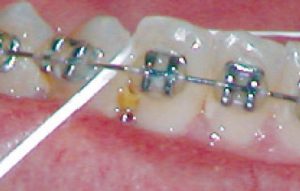
This is not an emergency, but can be a little uncomfortable or embarrassing for the braces-wearing patient. It is easily fixed with a piece of dental floss. Try tying a small knot in the middle of the floss to help remove the food. Or use an interproximal brush or toothpick to dislodge food caught between teeth and braces.
Lost Wire or Ligature
Tiny rubber bands or small, fine wires, known as ligatures, hold the wire to the bracket.
If a rubber ligature should come off, you may be able to put it back in place using sterile tweezers. If a wire ligature comes loose, simply remove it with sterile tweezers. If the wire ligature is sticking out into the lip but is not loose, it may be bent back down with a Q-tip or pencil eraser to eliminate the irritation.
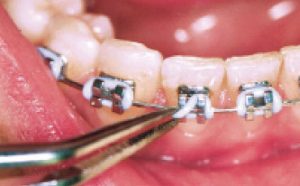
Of course, when one ligature pops off or breaks, others may follow. Be sure to examine all ligatures on your braces to make sure others are not missing as well. Please call our office to schedule a time to replace any loose or lost ligatures.
Discomfort
It’s normal for a patient to have discomfort for a day or two after braces or retainers are adjusted. But it can make eating uncomfortable. This discomfort is both normal and temporary. While there is still soreness, continue eating soft foods. Rinsing with warm salt water is helpful. Dissolve one teaspoonful of salt in eight ounces of warm water and then rinse your mouth vigorously. If the tenderness is severe, take an over-the-counter pain reliever that you would normally take for a headache or similar pain, such as acetaminophen or ibuprofen.
Mouth Sores
Some patients are susceptible to episodes of mouth sores. While braces do not cause them, they may be precipitated or exacerbated by an irritation from braces. One or several areas of ulceration of the cheeks, lips or tongue may appear. This is not an emergency, but may be very uncomfortable for the patient. Prompt relief may be achieved by applying a small amount of topical anesthetic (such as Orabase or Ora-Gel) directly to the ulcerated surface using a cotton swab. You can re-apply as needed. Additionally, you may use an antiseptic rinse called Peroxyl to provide comfort due to mouth sores. Read below for more information about Peroxyl.
Irritation in Mouth
Sometimes new braces can be irritating to the mouth, especially when the patient is eating. A small amount of non-medicinal relief wax makes an excellent buffer between metal and mouth. Simply pinch off a small piece and roll it into a ball the size of a small pea. Flatten the ball and place it completely over the area of the braces causing irritation. You can then eat more comfortably and go about your day. If the wax is accidentally swallowed it’s not a problem. The wax is harmless. Also, an antiseptic rinse called Peroxyl is helpful in relieving minor irritaition. Peroxyl, a hydrogen peroxide antiseptic mouth rinse, will reduce inflammation to your gums and cheeks. Peroxyl helps to prevent infection and decrease irritation that may develop from your braces. Rinse your mouth with two teaspoons of Peroxyl (half a capful) for one minute and then spit it out. You may use Peroxyl up to four times daily following your schedule for brushing: after meals (or after school) and before bed. Just like using peroxide for a scrape on your skin, Peroxyl helps the inside of your mouth heal. Peroxyl is not just for general irritation from braces, it can be used for canker sores, cheek bites and other minor temporary injuries to the gums.
Loose teeth
During the course of treatment, if your teeth begin feeling a little loose, don’t worry; this is normal and temporary! Your braces must first loosen your teeth so they may be moved into the right position. Once your teeth are in the right spot, they will no longer be loose.
Protruding Wire
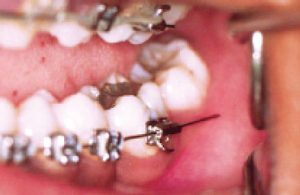
Occasionally the end of a wire will work itself out of place and irritate the mouth. Use a Q-tip or pencil eraser to push the wire so that it is flat against the tooth. If the wire cannot be moved into a comfortable position, cover it with relief wax as shown above. In a situation where the wire is extremely bothersome and the wax is not helping you may clip the wire.
Reduce the possibility of swallowing the snipped piece of wire by using folded tissue or gauze around the area. Use a pair of sharp clippers and snip off the protruding wire. Relief wax may still be necessary to provide comfort to the irritated area.
Loose Bracket or Band
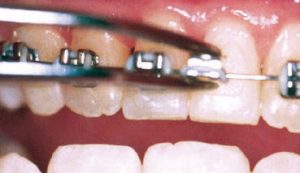
If you notice that one of your brackets or bands has become loose and is still attached to the wire, you should leave it in place and put wax on it to provide stability. If the bracket comes out entirely, wrap the bracket with a tissue.
Loose Wire
Using a pair of tweezers or needle nose pliers, try to put your wire back into place and add wax for stability. If doing this and using wax doesn’t help, as a last resort use a small fingernail clipper or wire cutter to clip the wire behind the last tooth to which it is securely fastened. If your discomfort continues, place wax on it.
A Bracket is Knocked Off
Brackets are the parts of braces attached to teeth with a special adhesive. They are generally positioned in the center of each tooth. The bracket can be knocked off if a patient has eaten one of those hard or crunchy foods orthodontic patients are instructed to avoid, or if the mouth is struck while at play. It is critical that protective mouth guards be worn during sports to avoid injury. If the bracket is off center, the adhesive may have failed and the bracket will be loose, however it will usually remain connected to the wire by a little rubber colored ring. To put the bracket back in place, use a pair of tweezers to slide the bracket along the wire until it is back to its proper position in the center of the tooth. If the bracket has flipped around, but is still attached to the wire, you can use the tweezers again to rotate the bracket back to the proper position, then slide it back to the center of the tooth. Call our office and inform us of your situation so we may schedule you to rebond the bracket.
Lost Separator
In case a rubber separator falls out, take two pieces of dental floss and insert them through the separator. Pull on both pieces of floss to stretch the separator, then slide the separator back and forth between the two teeth where it belongs. Once the bottom half of the separator slips under the tight spot between the teeth, release and remove the floss and the spacer will fit back properly. If you are unable to replace the separator, then call our office and leave a message for us in the event we are out of the office. This is not an emergency, but we do need to be notified that the separator has come out.
Headgear
Sometimes headgear discomfort is caused by not wearing the headgear enough hours as instructed. If the facebow is bent, call our office for assistance. The headgear should hurt less the more it’s worn, so be sure you’re getting in the prescribed hours. If one of the bands where the headgear is inserted becomes loose, discontinue headgear use and call our office to recement the loose band.
Palatal Expander – Loose Expander, Difficulty Turning or Tenderness
It may take a few days to get used to a palatal expander. Chewing, swallowing and talking may be awkward at first. The mouth and nose may be sore or may tingle. Some patients report a slight headache. You may use over-the-counter analgesics such as Tylenol or Advil to relieve discomfort. Anything that would normally be taken for a headache is okay to use. After only a few days of expanding, you may notice space between the front teeth. This is a good sign that the appliance is working and the palate is being expanded.
Most patients require braces about 3-4 months after all the expander activations have been completed.
If any part of the expander is poking you, place wax on the offending part. If a part of the expander, such as the band on one of the anchor molars becomes loose, push it back into place with your thumbs. Do not try to pull or yank on the expander to remove it. This will only make it worse by distorting the appliance and it will have to be refabricated. Call our office to schedule an appointment to recement the expander. If you are having difficulty turning your child’s expander, do not worry, this is not an emergency. Call our office to let us know and we will schedule an appointment to review turning instructions.
Swallowed Appliances
Remain calm if you swallow a piece of your appliance. This will usually go either into the stomach and pass out of the body in a bowel movement. However, if difficulty breathing is experienced, you should seek immediate medical attention. X-rays will be taken to determine the location of the swallowed piece.
